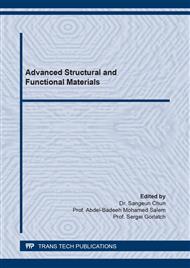[1]
Y. Sahin, Analysis of abrasive wear behavior of PTFE composite Using Taughi's Technique, Cogent Engineering 2(1) (2015) 1-15.
Google Scholar
[2]
H. Unal, A. Mimarolu, U. Kadioglu, H. Ekiz, Sliding friction and wear behavior of PTFE and its composite under dry sliding conditions, Materials and Design 25 (2004) 239-245.
DOI: 10.1016/j.matdes.2003.10.009
Google Scholar
[3]
F. Song, Q. Wang, T. Wang, Effect of glass fiber and MoS2 on tribological behaviour and PV limit of chopped carbon fiber reinforced PTFE composite, Tribology International 104 (2016) 392-401.
DOI: 10.1016/j.triboint.2016.01.015
Google Scholar
[4]
G. Venkateswarlu, R. Sharada and M.B. Rao, Effect of fillers on mechanical properties of PTFE based composites, Archives of Applied Science Research 7 (7) (2015) 48-58.
Google Scholar
[5]
S.M. Gujrathi, L.S. Dhamande, P.M. Patare, Wear studies on polytetrafluroethylene (PTFE) Composites: Taguchi Approach, Bonfring International Journal of Industrial Engineering and Management Science 3(2) (2013) 47-51.
DOI: 10.9756/bijiems.4406
Google Scholar
[6]
H. Unal, U. Sen, A. Mimaroglu, Dry sliding wear characteristics of some industrial polymers against steel counterface, Tribology International 37(9) (2004) 727-732.
DOI: 10.1016/j.triboint.2004.03.002
Google Scholar
[7]
L. Chang, K. Friedrich, Enhancement effect of nanoparticles on the sliding wear of short fiber-reinforced polymer composites: A critical discussion of wear mechanisms, Tribology International 43(12) (2010) 2355-2364.
DOI: 10.1016/j.triboint.2010.08.011
Google Scholar
[8]
V.N. Aderikha, V.A. Shapovalov, Mechanical and tribological behavior of PTFE–polyoxadiazole fiber composites: Effect of filler treatment, Wear 271(5-6) (2011) 970-976.
DOI: 10.1016/j.wear.2011.04.011
Google Scholar
[9]
Q. Wang, X. Zhang, X. Pei, Study on the synergistic effect of carbon fiber and graphite and nanoparticle on the friction and wear behavior of polyimide composites, Materials & Design 31(8) (2010) 3761-3768.
DOI: 10.1016/j.matdes.2010.03.017
Google Scholar
[10]
M. Yang, J. Yuan, X. Men, Z. Zhang, F. Guo, W. Liu, Effect of ZrB2 particles incorporation on high-temperature tribological properties of hybrid PTFE/Nomex fabric/phenolic composite, Tribology International 99 (2016) 289-295.
DOI: 10.1016/j.triboint.2016.03.033
Google Scholar
[11]
D. Zhang, H. Qi, F. Zhao, G. Zhang, T. Wang, Q. Wang, Tribological performance of PPS composites under diesel lubrication conditions, Tribiology International 115 (2017) 338-347.
DOI: 10.1016/j.triboint.2017.05.040
Google Scholar
[12]
J.T. Shen, M. Top, Y.T. Pei, M. De Hosson, Wear and friction performance of PTFE filled epoxy composites with a high concentration of SiO2 particles, Wear 322-323(15) (2015) 171-180.
DOI: 10.1016/j.wear.2014.11.015
Google Scholar
[13]
D.D. Desale, H.B. Pawar, Performance Analysis of Polytetrafluoroethylene as Journal Bearing Material, Procedia Manufacturing 20 (2018) 414–419.
DOI: 10.1016/j.promfg.2018.02.060
Google Scholar
[14]
W.G. Sawyer, K.D. Freudenberg, P. Bhimaraj, L.S. Schadler, A study on the friction and wear behavior of PTFE filled with alumina nanoparticles, Wear 254 (2003) 573–580.
DOI: 10.1016/s0043-1648(03)00252-7
Google Scholar
[15]
M. Shen, B. Li, Z. Zhang, L. Zhao, Abrasive wear behavior of PTFE for seal applications under abrasive-atmosphere sliding condition, Friction (2019) 1-13.
DOI: 10.1007/s40544-019-0301-7
Google Scholar
[16]
M. Wang, C. Zhang, X. Wang, The Wear Behavior of Textured Steel Sliding against Polymers, Materials 10 (2017) 330, 1-14.
DOI: 10.3390/ma10040330
Google Scholar
[17]
D-W. Kim, K-W. Kim, Effects of sliding velocity and normal load on friction and wear characteristics of multi-layered diamond-like carbon (DLC) coating prepared by reactive sputtering, Wear 297(1-2) (2013)722-730.
DOI: 10.1016/j.wear.2012.10.009
Google Scholar


